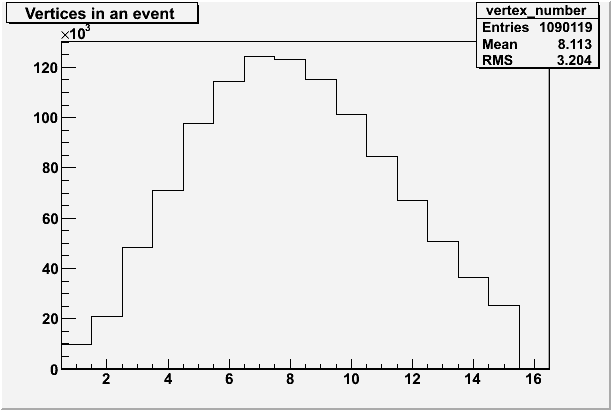
SL08C dAu Events total found using the getfilelist script with the conditions
production=P08ic,filename~st_upsilon, trgsetupname=production_dAu2008, filetype=daq_reco_MuDst,storage=nfs
This returns 1,210,691 events
Next the events are made into a tree and tracks with a corresponding tower are selected
The triggers and tracks per event were tested.
Events without the trigger Id 210601: 42578
Note: These numbers match those seen by Haidong
The run numbers of these events were recorded, they are the following:
9011028
9021028
8357057
9011041
9022062
8357059
After track-matching to the BEMC, events with no tracks: 77994
With these events removed this left the following total number of good events: 1090119.
This give a total set of good runs: 1508
The following plot show the number of interaction vertices (up to 15) in an event. For d-Au it has an average of 8 vertices per event, giving about 8M "sub-events".

|
The ranking is shown here, for all vertices
|
Now the ranking values for vertex[0] (the first vertex found)
|
Vz for different ranking values
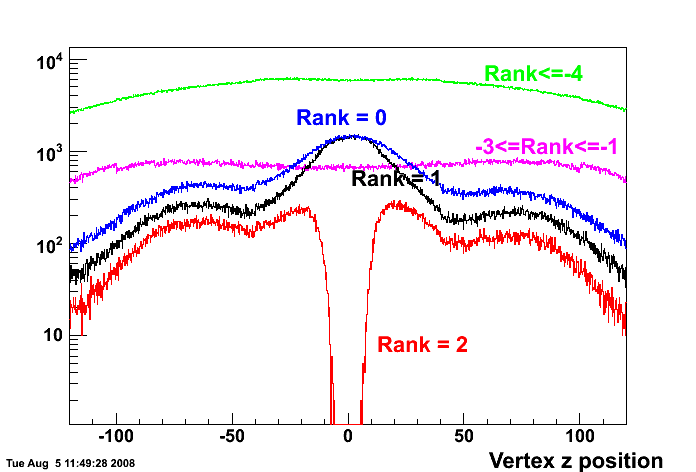
If rank =0 and = 1 for a vertex it will be saved. This leaves us with 1.06 Million events
It the dAu vertex was constructed using Minuit not the PPV finder, Marco sent a link to more information on this,
We found that there is a improvment in the quality of the VZ distribution if we use the first primary vertex in the array and select on the ranking between the following: 0 ≤ Ranking < 2.
Although it does not remove the wings, it can be seen that the rankings 0 to 1 converge with this selection giving cleaner Vz
|
Vertex[0], 0 ≤ Ranking < 2
| All primary vertices
|
First Vertex in array (vertex[0])
|
|
Vertex Z distribution:
|
Vertex Z distribution after ranking cut (rank==0 or rank==1)
|
Run number have been separated for clarity
Y7=Run-number within 8M-9M Y8:Run-number > 9M
A small investigation was done to see if these "wings" in Vz were run dependent
The multiplicity varied but it seems that the wings happen at all stages though the run. There is one case of very wide Vz in a run around 9014/9015
VZ vs. run Y7
|
VZ vs. run Y8
|
Ref_Mult averaged over vs. run Y7
|
Ref_Mult averaged over vs. run Y8
|
Vertex Z Y7 average vs. run
|
Vertex Z Y8 average vs. run
|
Pt Z Y7 average vs. run
|
Z Y8 average vs. run
|
Most of these run-by-run averages look reasonable. There are several runs that have outliers, for example, low multiplicity runs, some large vertex shifts and shifted Pt. The next step would be to pick the outliers and check the log books and see if there were beam/detector issues, maybe these should be removed to improve the quality of the dataset
Within an event the number of positive and negative tracks were counted. This plot looks stable
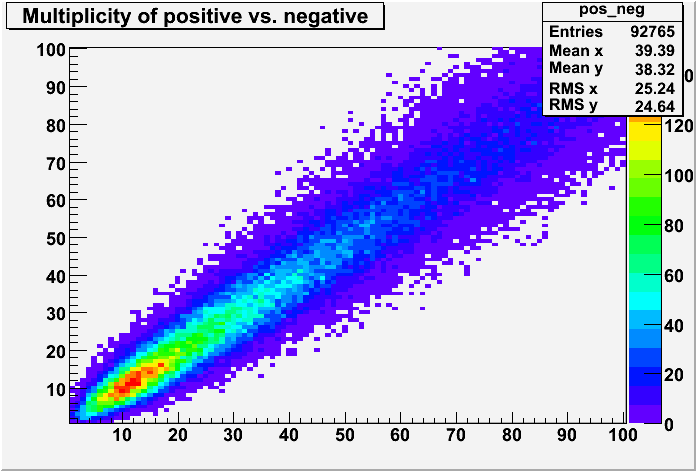
This is a summary of the L2ResultArray information. They all look OK apart from spikes in the L2 Z position, I checked my binning, it seems to be OK. Another point was the double peak in the L2 time is this as expected, I nievly thought that any timings would look smooth on average. Finally, L2 hot towers peaked at 25 and is by far the largest peak, it looks like it has hit a maximum value limit.
If we match the L0 triggered tower from the L2ResultsArray with the tower in an event and bit-shift the ADC >>4 this condition should give us back the L0 trigger distribution from the data.
We can also match the L2 tower from the L2ResultsArray with the tower.
This time we use (ADC-OnlinePedestal)>>4 this condition should give us back the L2 trigger distribution from the data.
|
ADC >> 4 L0tower==tower
|
Energy with L0tower==tower
|
|
(ADC - OnlinePed)>4 L2tower==tower
|
Energy with L2tower==tower
|
|
Cut |
Lower |
Upper |
|
dEdx |
3.2e-6 |
4.7e-6 |
|
dEdx tight |
3.4e-6 |
4.7e-6 |
|
P/E |
- |
2 |
|
P/E tight |
0.8 |
1.6 |
With a mimic trigger L0==(ADC)>>4 >18 and L2==(ADC-OnlinePed)>>4 ≥ 5
the dEdx distributions are
dEdx with no selections
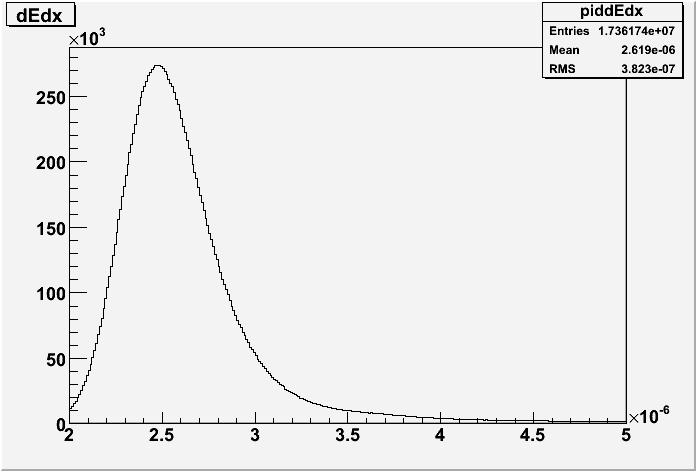
|
dEdx with mimic L0 trigger condition
|
dEdx with mimic L2 trigger condition
|
To really cut into the electron rich region, a tight P/E cut was applied and dE/dx plotted
|
dEdx, tight P/E with L0 mimic condition
|
dEdx, tight P/E with L2 mimic condition
|
Now onto P/E distributions
|
P/E
|
P/E with (p > 1.5)
|
P/E with mimic trigger condition
|
P/E with L0 mimic condition
|
P/E with L2 mimic condition
|
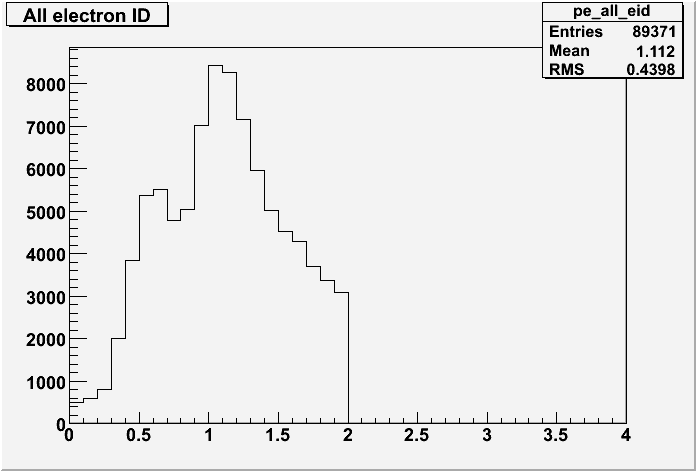
|
Remaining L0 electron candidates for loose cuts |
26941 tracks |
|
Remaining L2 electron candidates for loose cuts |
62430 tracks |
First we looked at ++ and -- signals
|
++
|
--
|
Is there something strange for ++ pairs around 11 GeV ?
With the dEdx cut 3.3e-6 to 4.7e-6
With P/E less then 2 (see above table)
Momentum of paired tracks > 1 GeV
Opening angle cos(theta) < 0.5 and Mass cut > 2 GeV/c
BG Pairs(++/--) scaled to 2sqrt(++*--)
Pair satisfied if it has mimic L0 condition applied to one track and mimic L2 condition to the other
|
Signal (black) Background (red)
Signal Minus Background
|
|
Mean |
9.511 |
|
Sigma |
0.896 |